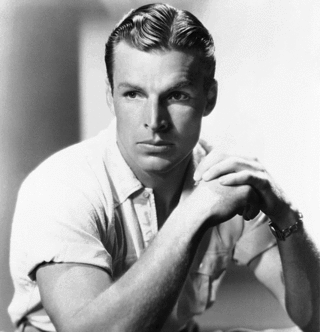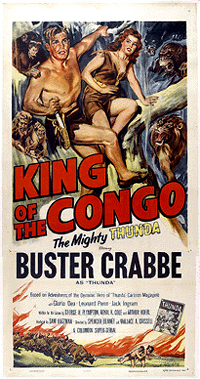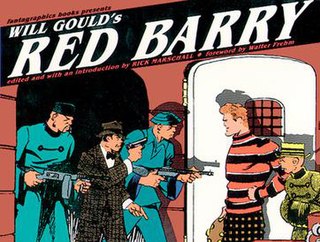
Flash Gordon is a 1936 superhero serial film. Presented in 13 chapters, it is the first screen adventure for Flash Gordon, the comic-strip character created by Alex Raymond in 1934. It presents the story of Gordon's visit to the planet Mongo and his encounters with the evil Emperor Ming the Merciless. Buster Crabbe, Jean Rogers, Charles Middleton, Priscilla Lawson and Frank Shannon portray the film's central characters. In 1996, Flash Gordon was selected for preservation in the United States National Film Registry by the Library of Congress as being "culturally, historically, or aesthetically significant".

Clarence Linden Crabbe II, known professionally as Buster Crabbe, was an American two-time Olympic swimmer and film and television actor. He won the 1932 Olympic gold medal for 400-meter freestyle swimming event, which launched his career on the silver screen and later television. He starred in a variety of popular feature films and movie serials released between 1933 and the 1950s, portraying the top three syndicated comic-strip heroes of the 1930s: Tarzan, Flash Gordon, and Buck Rogers.

All-American Comics was a comics anthology and the flagship title of comic book publisher All-American Publications, one of the forerunners of DC Comics. It ran for 102 issues from 1939 to 1948. Characters created for the title, including Green Lantern, the Atom, the Red Tornado, Doctor Mid-Nite, and Sargon the Sorcerer, later became mainstays of the DC Comics line.

Gold Key Comics was originally an imprint of American company Western Publishing, created for comic books distributed to newsstands. Also known as Whitman Comics, Gold Key operated this way from 1962 to 1984. Currently, Gold Key Comics is owned by Gold Key Entertainment LLC, which consists of business partners and comic book enthusiasts Lance Linderman, Adam Brooks, Mike Dynes, and Arnold Guerrero.
Spider Widow is a fictional superhero character that was published by Quality Comics during the Golden Age of Comic Books. The character was created by writer and artist Frank Borth, and debuted in Feature Comics #57, which bore a cover date of June 1942. Borth continued to write and draw the Spider Widow feature until the end of its run in Feature Comics #72.

Jungle Jim is the fictional hero of a series of jungle adventures in various media. The series began on January 7, 1934, as an American newspaper comic strip chronicling the adventures of Asia-based hunter Jim Bradley, who was nicknamed Jungle Jim. The character also trekked through radio, film, comic book and television adaptations. Notable was a series of films and television episodes in which Johnny Weissmuller portrayed the safari-suit wearing character, after hanging up his Tarzan loincloth. The strip concluded on August 8, 1954.

Hop Harrigan is a fictional character published by All-American Publications. He appeared in American comic books, radio serials and film serials. He was created by Jon Blummer, and was a popular hero originally through the 1940s, during the events of World War II.

Korak, a fictional character, is the ape name of John "Jack" Clayton III, the son of Tarzan and Jane Porter.

Tarzanesque is a term created by Frenchman Francis Lacassin used to describe characters in comic books inspired by Tarzan. A tarzanesque character resembles Tarzan in his physical resourcefulness, within a line of action that includes an adventurous life in the jungle, the gift of understanding and being understood by animals, contact with lost civilizations and courage combined with the ability to deal with nature. The creation of such characters may have been propitiated by the success that Tarzan had achieved since his appearance in literature in 1912, culminating with the release of daily comic strips in 1929, which paved the way for a genre that combined the allure of the unknown environment, the need for the archetypal characteristics of the hero and the popularity of access.

A jungle girl is an archetype or stock character, often used in popular fiction, of a female adventurer, superhero or even a damsel in distress living in a jungle or rainforest setting. An alternate depiction is a cave girl.

Gordon G. Rogers, better known as Boody Rogers, was an American comic strip and comic book cartoonist who created the superhero parody Sparky Watts.

Magazine Enterprises was an American comic book company lasting from 1943 to 1958, which published primarily Western, humor, crime, adventure, and children's comics, with virtually no superheroes. It was founded by Vin Sullivan, an editor at Columbia Comics and before that the editor at National Allied Publications, the future DC Comics.

The Skyman is a fictional comic book superhero that appeared stories during the Golden Age of Comic Books. Created by writer Gardner Fox and artist Ogden Whitney, the character first appeared in the Columbia Comics omnibus title Big Shot Comics #1. He is unrelated to the DC Comics character.

Jo-Jo, Congo King is a fictional character that appeared in comic books published by Fox Feature Syndicate. Jo-Jo first appeared in Jo-Jo, Congo King #7.

King of the Congo is a 1952 American 15 chapter movie serial, the 48th released by Columbia Pictures. It was produced by Sam Katzman, directed by Spencer Gordon Bennet and Wallace Grissell, and stars Buster Crabbe. The serial also co-stars Gloria Dea, Leonard Penn, Jack Ingram, Rick Vallin, Nick Stuart, William Fawcett, and Rusty Wescoatt. King of the Congo was based on the comic book character "Thun'da", created by Frank Frazetta, and published by Magazine Enterprises.
This is a timeline of significant events in comics in the 1920s.

Red Barry is a detective comic strip created by Will Gould (1911–1984) for King Features. The daily strip about two-fisted undercover cop Barry began Monday, March 19, 1934, as one of several strips introduced to compete with Dick Tracy by Chester Gould. A Sunday strip was added on February 3, 1935. The daily strip ran for three years, until August 14, 1937, and the Sunday page ended almost a year later, on July 17, 1938.

Cave Girl is a fictional jungle girl heroine who appeared in comic books published by Magazine Enterprises from 1952 to 1955, created by writer Gardner Fox and artist Bob Powell. The character's adventures are an example of artist Powell's good girl art.
Jack Schiff was an American comic book writer and editor best known for his work editing various Batman comic book series for DC Comics from 1942 to 1964. He was the co-creator of Starman, Tommy Tomorrow, and the Wyoming Kid.
Kevin the Bold was an American comic strip that premiered on October 1, 1950, with script and art work by Kreigh Collins. In the 1960s, however, he received script assistance from Jay Heavilin (1961) and Russell R. Winterbotham (1964-68). This well-written Sunday comic strip was published almost twenty years, telling the story about Kevin as an Irish agent under King Henry VIII of England in the 16th century.
















